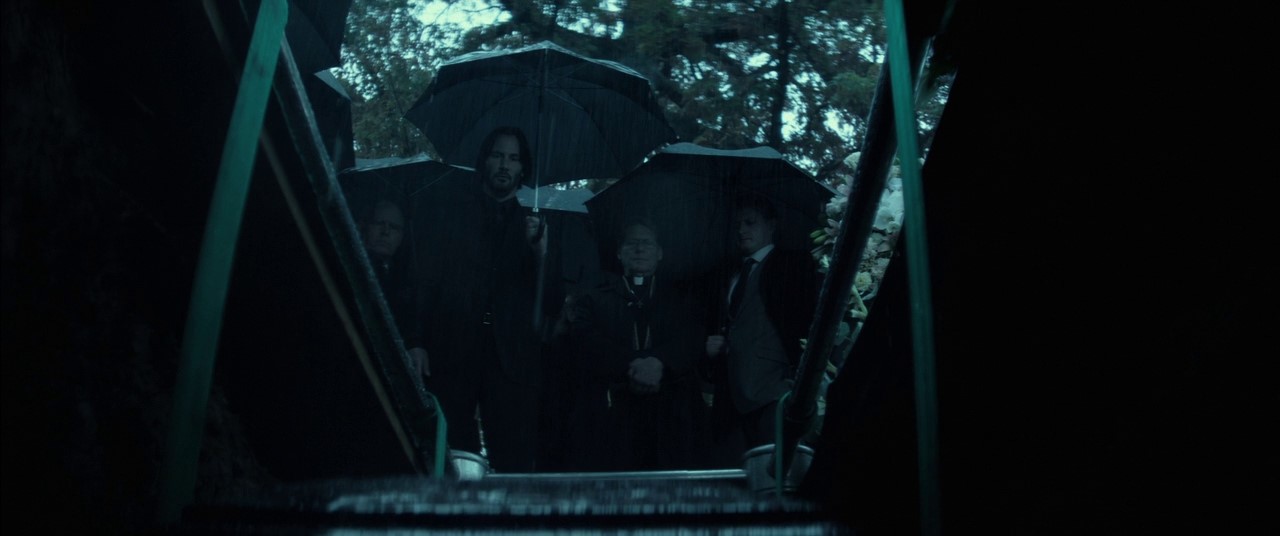
It is easy to assume that action films are artistically insignificant. Many people truly believe that action films are all the same and serve little to no purpose in terms of filmic artistry. However, this belief is harsh and inaccurate. There can be infinite meanings behind any film, and action movies are no exception. In this essay, I will solidify this argument with a well-known action film entitled John Wick (2014). We will analyze recurring motifs throughout the film, including the use of color, dark clothing aesthetic, guns, and violence. While these motifs are present in all three John Wick films, we will be focusing particularly on the first film in this piece.
John Wick follows a man of that moniker and his path to revenge. Starring Keanu Reeves as John Wick, this film creates an authentic and deeply emotional character study of a man consumed by his need for vengeance and justice. Following the death of his wife, Helen (Bridget Moynahan), and the raid committed by young mobster Iosef Tarasov (Alfie Allen) and his team of brutes, John Wick returns to his life as the infamous, seemingly immortal hitman. Tarasov makes the grave fault of mistaking John for a “fuckin’ nobody” (John Wick 23:24-23:35) then kills his dog, which was a final gift from his wife, and steals his car. The remainder of the film focuses both on John Wick’s ruthless and violent plight to enact his revenge on Iosef and his growing quarrel with crime lord and father to Iosef, Viggo Tarasov (Michael Nyqvist).
The Meaning Behind Color in John Wick
Diving first into the use of color in this film, it is necessary to start at the beginning after the death of John Wick’s wife, Helen. There is a noticeable use of dull, desaturated color throughout these opening sequences of the film. The funeral, of course, is the dullest point in the film in terms of color grading as well as costuming. As Wick continues with his life, carrying the weight of his wife’s death, there is a strict absence of bright color. While Wick’s home is being raided and attacked by Iosef and his thugs, audiences are still subjected to dull coloring. The effect of this sort of color grading is strong; it is reflective of John’s turmoil and depression. The dullness of the color palette also works to mirror the newfound emptiness John now feels after his wife’s death. It could also be bringing out a subconscious feeling of emptiness that John has after retiring from his previous life of crime.
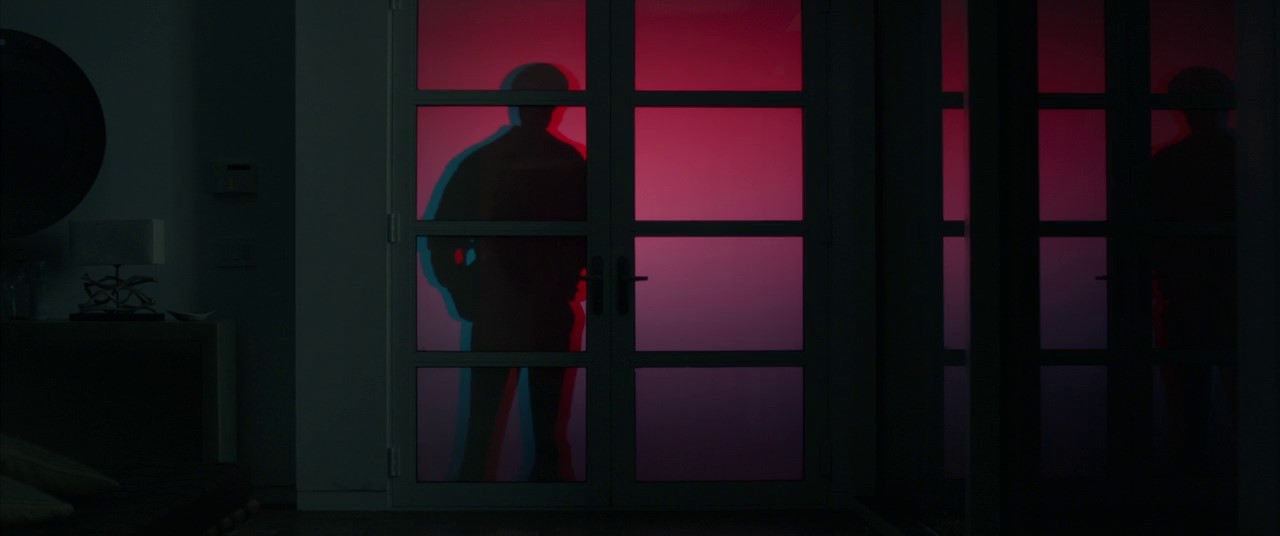
About thirty minutes into the film, we see our first real pop of color. The color red in the police lights stands out as the police arrive at John Wick’s house following another attack, this time at the hands of Viggo Tarasov. The use of red here is very important because as you take a closer look into the use of color in the film, you will realize that this is foreshadowing Wick’s violence later in the film, as well as his descent back into the criminal underworld.
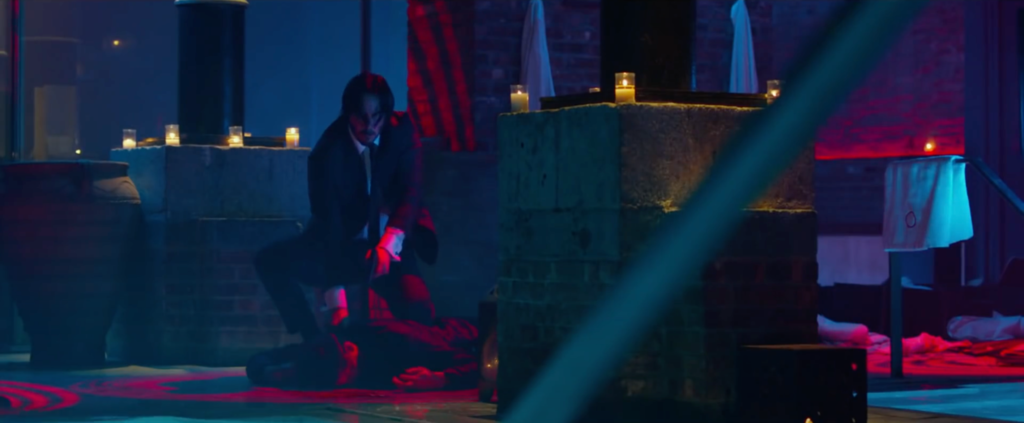
The most noticeable and arguably most important use of color in John Wick is displayed throughout the fight scenes that take place in the Red Circle. It is here in the Red Circle that Iosef hides from Wick, essentially awaiting the inevitable attack. As Wick invades this underground club of criminals, we see strong, vibrant reds and blues within the set dressing, lighting, and color grading. These saturated colors and bright blue and red lights reflect the sort of ethereal feeling that is so prevalent in the so-called “underworld.” Like most action films, the world of John Wick is a fantastical, “fictional universe” (Eyrenci) that essentially calls attention to its dystopian, unrealistic nature. The story glorifies the criminal underworld, but in the real world we experience the exact opposite. The filmmakers do well to highlight this glorification through the editing and use of color throughout the Red Circle fight sequence. They intercut between moments of intense bright colors during the fighting down below and the dull colors of the city above. Thus, the audience is able to better understand the reverence of the underworld within John Wick. On the other hand, when we are aboveground, in the city, the drab world works to reflect John Wick’s desire to return to the inherent excitement of crime. With the bright colors of the Red Circle, we are able to connect the violence and fighting to something beautiful, and the dullness of the world above to something boring and ordinary.
What’s Up with John Wick’s Clothes?
Moving into costuming, there is quite a bit of analysis to unpack here. If you watch all of the John Wick movies, you will notice that John is almost always wearing dark colors. It is only in the first film, when we see him wearing his pajamas, that he is not dressed in black. There could be several reasons for this and below we will dive into some of those possible meanings.
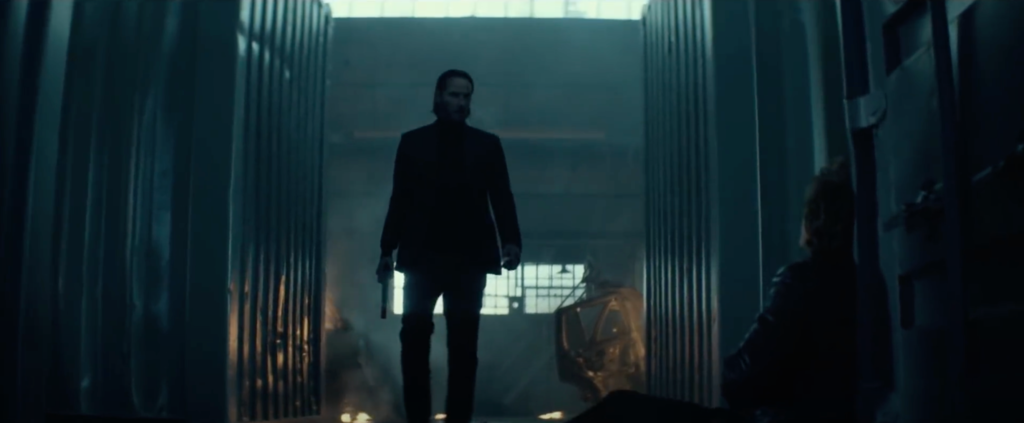
A discrepancy has to be made between John Wick’s all-black suits and his black and white suits. When we see John at a heightened emotional state or during instances of extreme violence, he is always wearing entirely black clothes. Audiences will see this at the beginning of the film at his wife’s funeral, when Viggo’s men attack John in his home, John’s arrival to the Continental, during the killing of Iosef, and the final fight with Viggo. In all of these instances, John is experiencing either an extremely emotional moment, or engaging in harsh violence. The dark clothes reflect John’s state of turmoil and despair as he mourns the death of his wife, the murder of his dog gifted to him by Helen, and his insistent violence.
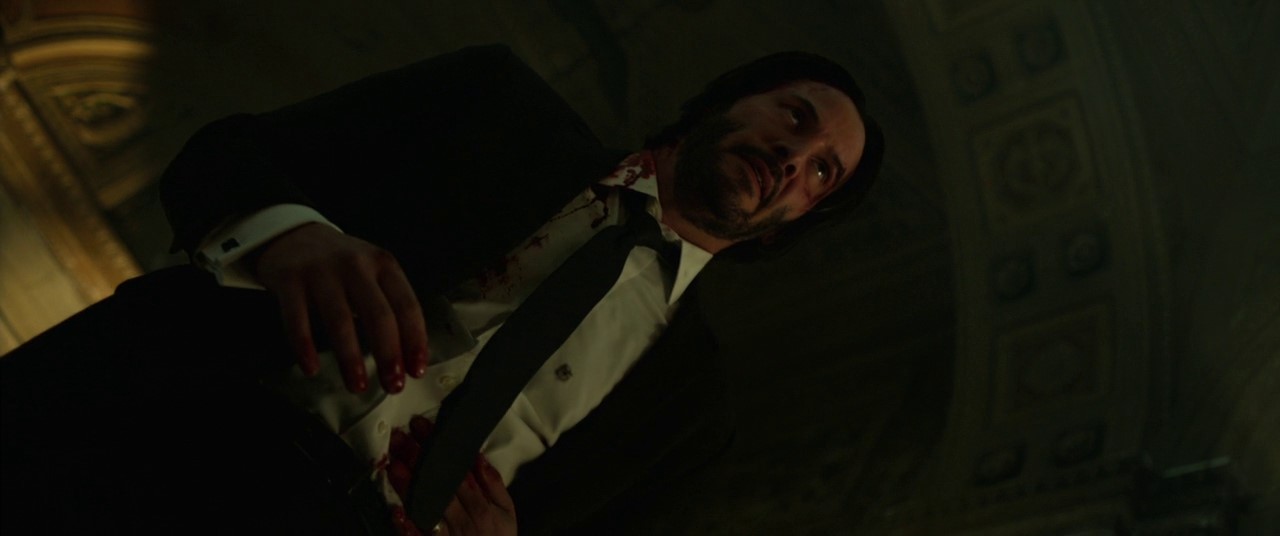
It is important to note that the only instance (apart from the scenes where we see John in his pajamas) where John is not wearing full black is throughout his fight scenes in the Red Circle. Instead, he is wearing a black suit with a white shirt underneath, so we still keep with the black suit motif but with some added white. Now there could be several reasons for this costuming choice. The first being that perhaps the use of white in John’s outfit was utilized to help his character stand out among all of the other hitmen dressed in dark clothing, and also to create a contrast against the bright red and blue colors. Another thought is that the white could be used to better display John’s injuries that he obtains during the sequence. This fight scene marks the first true interaction between John and Iosef following the latter’s attack on Wick’s house. The blood on his white shirt could be an important distinction made by the costumers to display the fact that John has now officially got his hands dirty again. The blood on his shirt also could be a purposeful choice in that we get to see John actually showing damage, proving to us that he is not impervious to injury.
Guns and Violence in John Wick
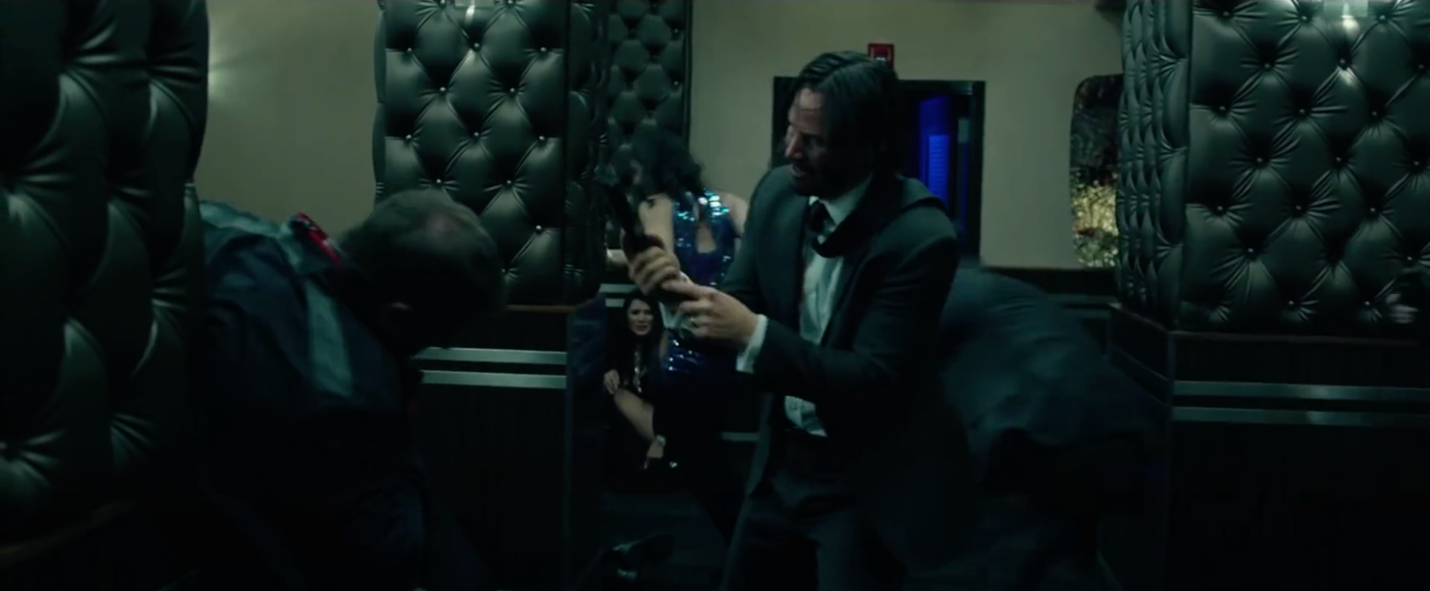
Action movies are always packed full of violence and usually include a superfluous number of guns in them, and John Wick is no different. However, there is a notable aspect of John Wick that makes it stand out among the rest: HE RELOADS HIS GUNS. Taran Butler is Keanu Reeves’s “gun-fu” trainer and he has talked extensively about the importance of creating realistic shooting sequences with realistic reloading. It is for this reason that I feel it is important to touch on this recurring motif across all three films. As previously stated, the guns and violence are prevalent throughout the action genre, but what makes the use of violence in John Wick unique is the drive behind John’s choices. Everything he loves has been taken from him and it is for that reason that he feels the urge to enact revenge. In order for an action film to really connect with an audience like John Wick does, the main character needs to “have a moral side” and the “fights must happen for a reason, and the reason must be justified” (Eyrenci). In John’s case, his reason is justified given his circumstances: his late wife, for whom he gave up his life as a hitman, gifted him a dog from beyond the grave and a thief remorselessly took that from him.
Conclusion
While there are countless motifs and symbols used throughout John Wick, these three stand out from the rest for their ambiguity. We are able to do an extensive analysis of these motifs, beyond what you have just read and there are a number of meanings behind the filmmakers’ choices that we can imagine. What we do know is that the use of color, specific costuming, and meaningful violence make John Wick stand out among its action genre counterparts.
Author Biography
G.M. Smith is an undergraduate student at the University of North Carolina at Wilmington seeking a degree in Film Studies and Film Production. Her primary interests lie in producing, screenwriting, and casting. Her favorite film is Quentin Tarantino’s Once Upon a Time in Hollywood (2019).
References
Eyrenci, Duygu. “Action Movies: The Cinema of Striking Back.” Film Matters, vol. 4, no. 2, Summer 2013, p. 63. EBSCOhost, http://search.ebscohost.com.liblink.uncw.edu/login.aspx?direct=true&db=f3h&AN=97946003&site=ehost-live
Friedell, Bill. “John Wick: Lighting the Underworld.” Cinemablography, 20 May 2019, www.cinemablography.org/blog/john-wick-lighting-the-underworld.
Stahelski, Chad. John Wick. Lionsgate, 2014.
Wells, Jonathon. “The Story Behind Keanu Reeves’ Impeccable John Wick Suit.” The Gentleman’s Journal, 23 May 2019, www.thegentlemansjournal.com/article/story-behind-keanu-reeves-impeccable-john-wick-suit/.







































